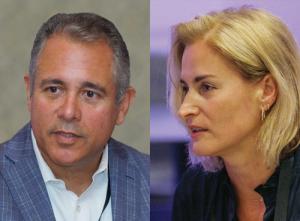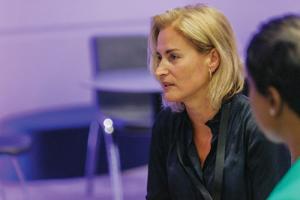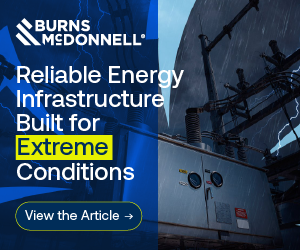Con Ed
Bob Sanchez is Shared Services President at Con Ed. Silvia Khurrum is Project Manager Research and Development at Con Ed.
Amid the keynotes, panels, and networking breaks at Edison Congress 2025, the PUF team was able to catch up with leaders from Con Ed. Including from a panel on the conference's first day, with a group of senior electric utility leaders, the President of Con Ed Shared Services Bob Sanchez.

So, we sat down and talked about the challenges and opportunities in New York and nationally across our industry. Silvia Khurrum, Con Ed Project Manager Research and Development, also talked about the State and Future of Power. Check out this great conversation which will take you slightly more than a New York minute to peruse.
PUF's Steve Mitnick: What are your roles at Con Ed, and what do you do on a typical day?
Bob Sanchez: I am the President of Shared Services at Con Edison with a focus on ensuring our shared services can scale to meet the increased pace and scope required to serve our customers and advance the clean energy transition.
 Bob Sanchez: We make continuous investments in the systems to strengthen services we provide and to maintain our nation-leading electric reliability, while balancing costs. Innovation that helps to eliminate future operation and maintenance costs is critically important.
Bob Sanchez: We make continuous investments in the systems to strengthen services we provide and to maintain our nation-leading electric reliability, while balancing costs. Innovation that helps to eliminate future operation and maintenance costs is critically important.
Silvia Khurrum: I'm a manager in research and development. In my typical day, I focus on how to bring innovative solutions from pre-commercial and commercial stages through piloting into the market.
I evaluate new technologies and end-user applications that can make a significant impact in reducing greenhouse gas emissions from buildings, as that is one of the leading causes of GHG emissions in New York City. After balancing considerations that include affordability and climate goals, we then explore strategies on how Con Edison can adopt and scale to maximize the benefits for our customers and the grid while advancing New York policy priorities.
PUF: Give a sense of how Con Ed has become an innovation machine.
Bob Sanchez: Like many of our peers, we make continuous investments in the systems to strengthen services we provide and to maintain our nation-leading electric reliability, while balancing costs. Innovation that helps to eliminate future operation and maintenance costs is critically important for our customers.
 Silvia Khurrum: We’re already thinking a step ahead on low-carbon resources that will help us decarbonize our steam systems, such as hydrogen. We’re also looking into the methane detectors. So, we’re already building devices and technology for the future possibilities of the decarbonizing grid.
Silvia Khurrum: We’re already thinking a step ahead on low-carbon resources that will help us decarbonize our steam systems, such as hydrogen. We’re also looking into the methane detectors. So, we’re already building devices and technology for the future possibilities of the decarbonizing grid.
The affordability of the vital services we provide is always front and center. So, when we're making investments in our infrastructure to deliver safe, reliable, resilient services, we're looking at ways we can reduce costs.
One of the items I mentioned earlier was tied to a gas-enabled methane detector that we've been installing. That was closely tied to our AMI, our smart meter investments. From that, we're able to receive an alarm before our customers even know there's a gas leak nearby.
It's important for us to make these types of investments as they make our system safer and more reliable for our customers and also improve our operating efficiency. So, there is a lot of value in these types of investments.
PUF: What about saying, "It's an interesting technology. That's going to make a difference for customers," versus, "We're trying to keep costs down, that's a risk." How do you decide to implement, and field test that tech and get it into the field?
Silvia Khurrum: To tie into Bob's comments, the AMI natural gas detector detects natural gas ten percent before the low explosive limit is reached. These are currently detecting natural gas, and the technology has the capacity to detect other kinds of gases. While this is what we have today, we're already thinking a step ahead on low-carbon resources that will help us decarbonize our steam systems, such as hydrogen. We're also looking into the methane detectors.
So, we're already building devices and technology for the future possibilities of the decarbonizing grid. That's one example.
These investments make sense for our customers, technology that keeps our customers safer, or technology that improves our operations or efficiencies while balancing affordability.
Often, many R&D solutions come from in-house at Con Edison. Sometimes, reducing energy and changing behavior doesn't require new technology. It's more of the culture or operational changes that don't have dollars associated with them.
PUF: Bob, where's Con Ed going in partnership with its customers in the vibrant area you serve, two to four years from now?
Bob Sanchez: Our focus is to support our customers as they transition to a clean energy future while continuing to provide safe and reliable power.
For customers who want to charge their electric vehicles, we want to make sure that the service is provided. For customers who want to take their form of heating and with electrification, convert it to electric, we want to be there for them.
Typical service requests that come in today are about one hundred twenty-five percent more than what we used to receive. We're seeing that increase in requests coming in, and our role is to ensure the infrastructure is there to support their choices.
The industry has taken many steps to help customers understand this transition. Energy efficiency ten years ago was brand new. Today, it's front and center, and is a quarter of the business.
These are the investments we need to make today to build the grid of the future and support our customers' energy demand, so that ten years from now, we're not necessarily thinking about the electrification of heating because that's already part of the system. It's important that we're thinking about how we're supporting our customers today and in the future, making sure we're doing it in a reliable and economical manner. Affordability remains top of mind for the industry more broadly.
PUF: Silvia, New York City has a lot of old buildings and streets. How do you look at the challenge with Con Ed and your team and say, "This is the best and most affordable way to do it?"
Silvia Khurrum: A lot of investments are made assuming a certain grid emission intensity. As the grid is decarbonizing, as the renewables are coming on, or not, the grid coefficient should be going down for the emission coefficient.
It is a balancing act of what happens on the demand side, reflecting what should be happening on the supply side. We're paying a lot of attention to the grid overall in terms of emission intensity, technologies needed to ensure compliance with Local Law 97, for instance, alongside energy demand.
It's complicated. But in terms of what kind of technologies are out there, there are plenty. It's the art of designing and optimizing it for the long term.
PUF: Bob, you are Chair of the Association of Edison Illuminating Companies, AEIC. You have a perspective industry-wide. Where is this industry going?
Bob Sanchez: I believe this industry is heading in the right direction. What's important is that the industry as a whole has the right attitude. Everyone rolls up their sleeves. They're supportive of one another and mutual aid is a great example of that.
If someone's service territory has been impacted by storms in one area, resources can come from across the nation to help support response and recovery. The industry has the right mindset because we're focused on providing safe, reliable service for our customers in the most economical way possible.
PUF: Silvia, you also work with colleagues across the country, so how does that collaboration work?
Silvia Khurrum: It's exponential. I have to agree with Bob again. I have pride in our industry as we collaborate well. There are a lot of support structures and information sharing.
We are part of many collaborations, and I think the information and the quality of not only academia, startups, and industries, but also the access and speed of information we can share, is truly beneficial for sorting out what solutions are effective or not.



